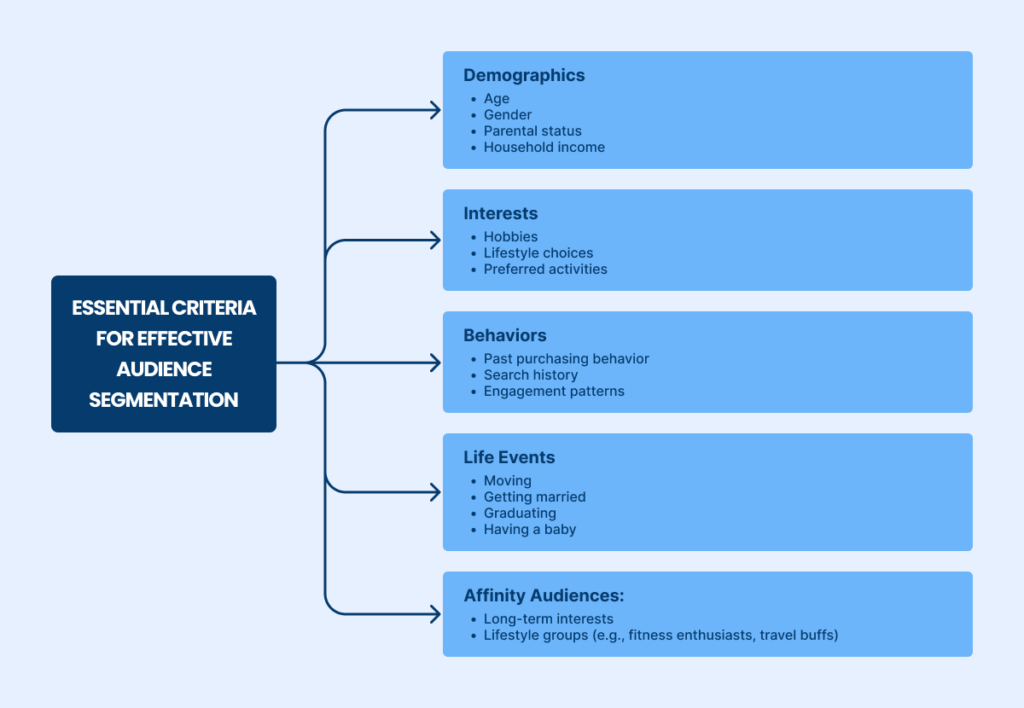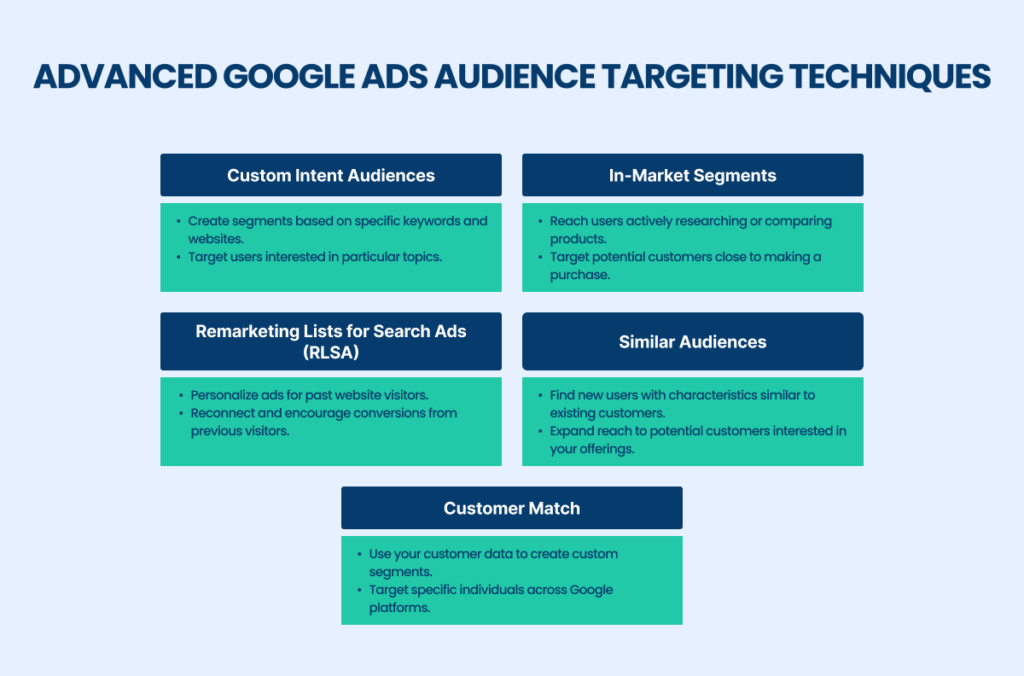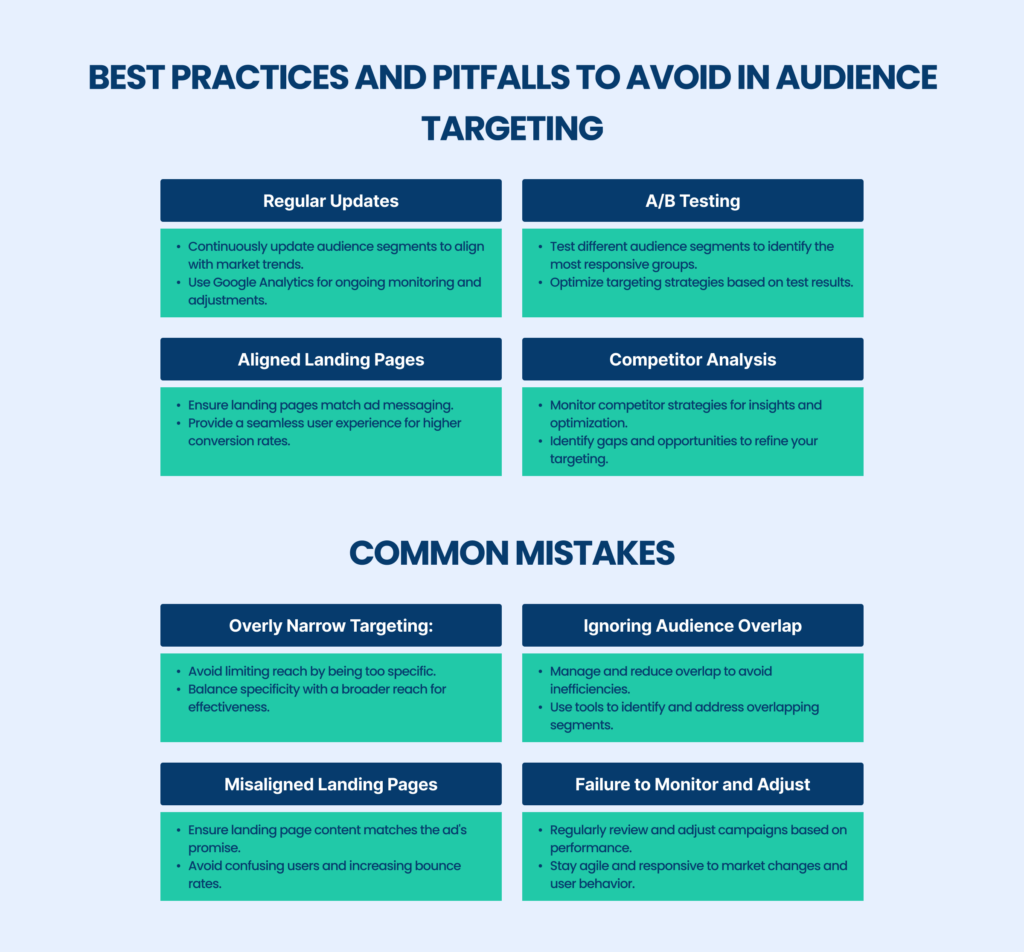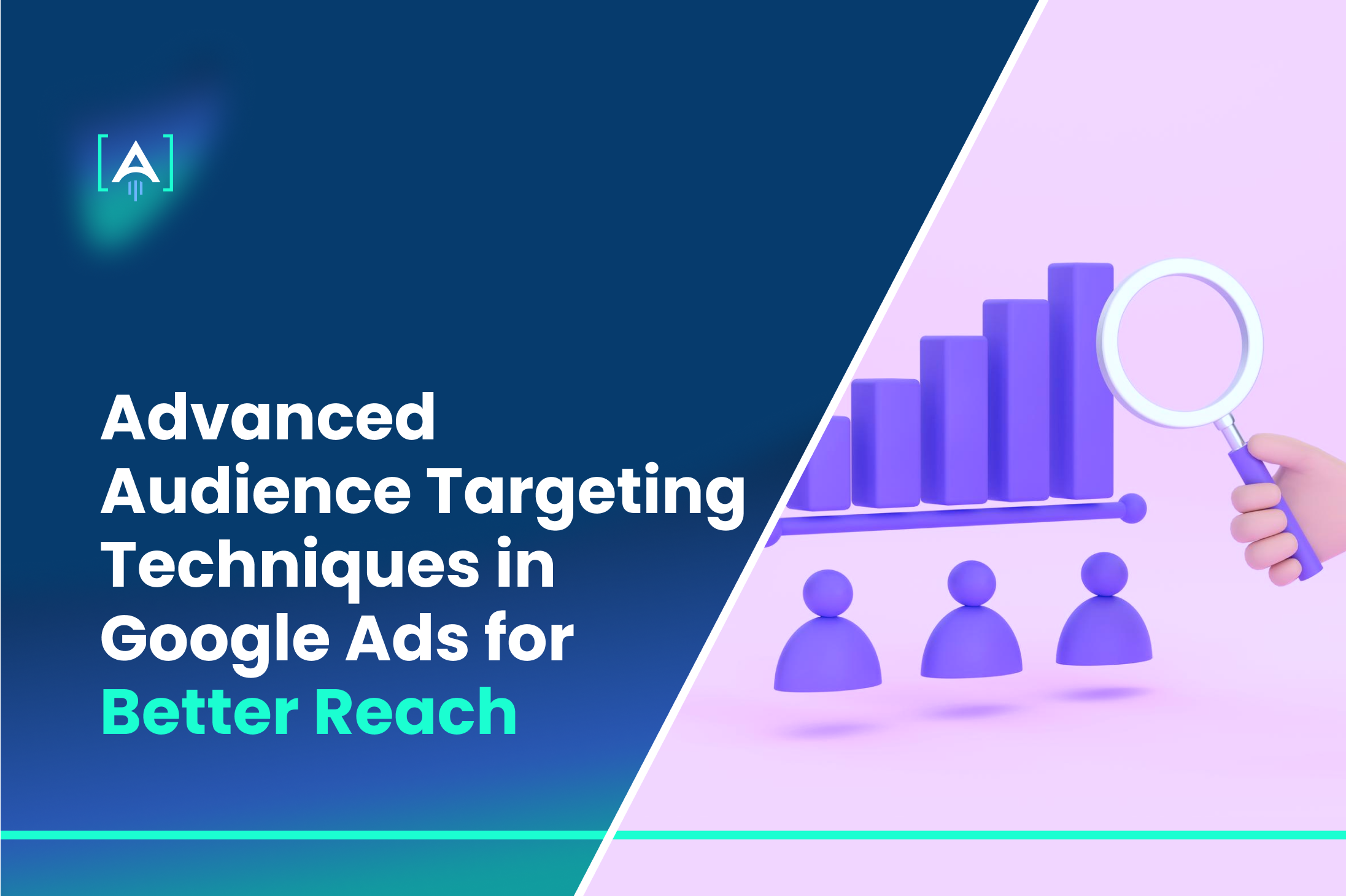Knowing the right audience is a huge factor in success in the world of digital marketing. In this scenario, Google Ads’ audience targeting comes in handy.
With state-of-the-art targeting methods, businesses can expose their ads to relevant viewers at the best possible time.
A suitable means would be to team up with a Google Ads Agency to find a more specialized talent pool to work flexibly with all these tools.
Google Ads audience targeting allows businesses to target specific demographics, interests, and behaviors. This personalization can maximize campaigns for effectiveness and drive home the ROI.
Demographic targeting, in-market audiences, custom intent audiences – Google Ads has all the tools to help you reach your target audience.
From generating new leads to re-engagement campaigns for existing customers, it can all be tailored.
This article will review the advanced audience targeting techniques available in Google Ads and how to leverage those to accomplish your marketing goals.
What are these powerful tools, and how do you use them effectively to grow your business with targeted advertising?

Understanding the Basics of Audience Targeting
Understanding how Google Ads audience targeting works is essential for businesses. It allows them to strategically reach the right people at the right time by focusing their efforts on specific subsets of the audience.
This understanding is key for making informed decisions and optimizing advertising strategies, thereby maximizing the effectiveness of campaigns.
What is Audience Targeting?
Audience targeting in Google Ads means identifying what prospects or customers are and then segmenting them into demographics, interests, and behaviors to create genuinely personalized ads that have the best opportunity to perform for each audience segment.
Importance of Audience Segmentation
Creating audience segments is very important in tailoring marketing messages. Breaking down large audiences into smaller segments can improve ad targeting.
Critical segmentation criteria in Google Ads include:
- Demographics:
- Age, gender, income, and parental status.
- Example: Targeting high-income households with luxury product ads.
- Interests:
- Based on hobbies and lifestyle choices.
- Example: Advertising fitness gear to health-conscious individuals.
- Behaviors:
- Past purchasing behavior or search history.
- Example: Retargeting users who have previously searched for similar products.

The Role of Google Ads Audience Targeting
Effective audience targeting in Google Ads significantly increases ad relevance and boosts overall campaign performance.
According to a Google report, using audience targeting can result in a 20% improvement in click-through rates (CTR) and a 50% reduction in cost-per-acquisition (CPA), demonstrating its efficiency and effectiveness.
Businesses gain a strategic advantage by leveraging audience targeting and tools like Google Ads competitor analysis.
This precision targeting ensures that ads are not just widely seen but are seen by the right people, making it an indispensable part of a successful digital marketing strategy.
Advanced Google Ads Audience Targeting Techniques
Mastering advanced Google Ads audience targeting techniques can significantly enhance your campaign’s performance.
By utilizing sophisticated targeting options, businesses can better connect with potential customers and optimize their advertising spend.
Below are several advanced audience targeting techniques that can help maximize your campaign’s effectiveness.
Demographic Targeting
Demographic targeting allows you to reach audiences for Google Ads based on characteristics like age, gender, parental status, and household income.
This targeting benefits businesses with products or services suited to specific demographic groups. For example, a luxury brand might focus on higher-income households.
In-Market Segments
In-market segments allow you to reach people searching or being interested in buying products or services like the one you offer.
By targeting these Google Ads audiences, you can reach potential customers closer to the end of the purchasing cycle, increasing the likelihood of conversion.
For instance, targeting users in the “Travel” in-market segment could benefit a travel agency looking to attract customers to book vacations.

Custom Intent Audiences
Custom intent audiences enable advertisers to create tailored audience segments based on specific keywords and websites in which potential customers have shown interest.
This allows you to target ads to users more likely to be interested in your offerings. For example, if you have an online electronics store, you can target users who have searched for “best smartphones” or visited tech review sites.
Remarketing Lists for Search Ads (RLSA)
Remarketing Lists for Search Ads (RLSA) helps you personalize search ads for people who have previously visited your website.
This technique is powerful for reconnecting with past visitors and encouraging them to complete a purchase.
By adjusting your bids and ad copy for these audiences, you can tailor your messages to encourage conversions.
Similar Audiences
Similar audiences in Google Ads are created based on your existing remarketing lists.
Google analyzes your audience data and identifies new users with similar characteristics. It helps you increase your reach to people who could be similar to those in your customer base.
For instance, if you have a remarketing list of users who purchased hiking gear, Google can find similar users who might also be interested in outdoor activities.
Affinity Audiences
Affinity audiences allow advertisers to target people based on their lifestyle, interests, and passions.
These audiences are grouped by their long-term interests and habits, making connecting with users with a strong interest in specific topics more accessible. For example, a sports apparel brand might target users interested in “Fitness Enthusiasts” or “Sports Fans.”
Life Events Targeting
Life event targeting enables advertisers to reach users during significant milestones, such as moving, getting married, or graduating.
These considerable life changes often correlate with shifts in purchasing behavior. For example, targeting users who are moving can be ideal for businesses offering home services or furniture.
Customer Match
Customer Match enables businesses to use their customer data, be it email addresses or phone numbers, in reaching users across Google Search, Shopping, YouTube, and Gmail.
This feature is valuable for re-engaging existing customers or targeting similar users. For example, you can upload your customer list to Google Ads and show tailored ads to your past customers when they search for related products.
These advanced techniques in targeting audiences in Google Ads provide very strong levers to reach and engage with very relevant potential customers.
By combining these strategies with negative keywords and precise ad group segmentation, businesses can further refine their campaigns and enhance performance.
Whether you’re looking to attract new customers or re-engage existing ones, these methods offer a versatile approach to maximizing the effectiveness of your Google Ads campaigns.
Combining Targeting Options for Better Results
Integrating various Google Ads audience targeting techniques can immensely increase the impact of your advertising campaigns.
By combining different targeting strategies, businesses can achieve more precise and relevant ads, ensuring they connect with the right audience at the right time.
Layering Multiple Targeting Options
Layering different targeting options is a strategic approach to refining your Google Ads strategy.
For example, combining demographic Targeting with in-market segments helps advertisers reach users who fit a specific demographic profile and actively search for related products or services.
Examples:
- Demographics + In-Market Segments: Targeting young adults (ages 25-34) in the smartphone market.
- Interests + Demographics: Reaching tech enthusiasts who are also high-income earners.
Layering these options can make a more refined audience likely to engage with your ads and convert.
For instance, a tech company might target young, high-income males interested in the latest gadgets, combining demographic and interest-based Targeting to optimize ad relevance.
Using Combined Audience Segments
Combined audience segments allow advertisers to merge multiple criteria, such as demographics, interests, and behaviors, into one particular group. This is especially useful for targeting niche markets or specific consumer profiles.
Examples:
- Affinity Audiences + In-Market Segments: Targeting “Fitness Buffs” who are in-market for gym memberships.
- Life Events + Demographics: Reaching recently married individuals within a particular age range.
Using combined audience segments, a wedding planning service could target recently married couples interested in luxury travel, combining life events with interest-based Targeting to provide highly relevant ads.
Implementing Customer Match with Other Targeting Options
Customer Match allows businesses to use their customer email addresses or phone numbers as data to target specific individuals across Google Search, YouTube, and Gmail.
Advertisers can reach users with highly relevant offers during crucial moments by combining Customer Match with other targeting options, like life events or in-market segments.
Examples:
- Customer Match + Life Events: Target customers in your database who are about to move and offer them moving or home decor services.
- Customer Match + Demographics: Using customer data to reach specific age groups or income levels with personalized promotions.
A luxury furniture retailer might use Customer Match data to target existing high-income customers who are also experiencing a life event, such as moving, and offer them exclusive deals on home furnishings.
Utilizing Negative Keywords to Refine Targeting
Adding negative keywords to your ad groups helps ensure your ads don’t appear in irrelevant searches, optimizing your budget by excluding unwanted traffic.
Examples:
- Excluding Irrelevant Terms: If selling premium watches, use negative keywords like “cheap” or “affordable.”
- Refining Search Ads: For a luxury car dealership, exclude terms like “used” or “second-hand.”
Incorporating negative keywords can refine your Google Ads targeting by focusing only on the most relevant search queries, enhancing the effectiveness of your campaigns.
The business can leverage such techniques for more targeted and effective advertising campaigns.
Targeted advertising, especially when personalized, can significantly influence consumer behavior and improve engagement.
This insight emphasizes the importance of using a multifaceted approach in Google Ads audience targeting, ensuring that advertising investments are maximized by reaching the most promising audience segments.
Best Practices for Implementing Advanced Targeting
Implementing advanced Google Ads audience targeting techniques requires a strategic approach to effectively reaching your desired audience.
Google Ads reporting provides detailed insights into campaign performance, helping businesses refine their strategies for optimal results.
One essential practice is updating your audience segments regularly. As market dynamics and consumer behaviors evolve, keeping your target audiences aligned with current trends is crucial. Google
Analytics and tools like this can help you monitor these changes and adjust your targeting strategies accordingly.
Another important aspect is to test and optimize your targeting options continuously. This involves A/B testing different audience segments to determine which groups most respond to your ads.
By testing various combinations, including in-market segments or life events, you will then know which configurations are more effective at generating higher engagements and conversions.
Effective leveraging of Google Ads landing pages is also crucial. Your landing pages should be targeted at your Google Ads audience to ensure that the content speaks to their needs or interests.
This alignment can vastly improve conversion rates since users are most likely to participate with what directly appeals to their search intent and interests.
Monitoring competitor strategies is another valuable practice. You could better your knowledge of how your competitors use audience targeting in Google Ads to find gaps or blind spots in your plan.
Tools like competitor analysis provide:
- Valuable data on the audiences your competitors are targeting.
- The keywords they are using.
- The performance of their ads.
Lastly, integrating Customer Match with other targeting options can enhance your ability to connect with specific users.
Customer Match can target Google platforms using customer data like email addresses or phone numbers.
Combining this with other targeting criteria, like life events, enables you to deliver highly personalized ads at crucial moments, improving the overall effectiveness of your campaigns.
Common Mistakes to Avoid
While running Google Ads audience targeting, avoid common traps that may reduce the performance of your campaigns.
Overly Narrow Targeting
While it’s essential to define your target audience clearly, more than narrow targeting can limit your reach and reduce the effectiveness of your campaigns. Balancing specificity with reach is crucial, ensuring your ads are visible to a broader yet relevant audience.
Ignoring Audience Overlap
Overlapping audience segments can lead to inefficiencies in your campaigns, such as wasted ad spend and reduced ad relevance. Use tools like Google Analytics to identify and manage audience overlap and ensure that ads are exposed to different and more valued segments.
Misalignment of Landing Pages and Ads:
A common mistake is not aligning the messaging and content of your landing pages with the ads that lead to them. This misalignment can confuse and increase bounce rates. Ensure your Google Ads landing pages are tailored to the expectations set by your ads, providing a seamless and consistent user experience.

Failure to Monitor and Adjust:
Audience targeting in Google Ads is a dynamic process and requires ongoing monitoring and adjustment. Failing to review campaign performance regularly can lead to missed opportunities for optimization. Set up regular check-ins and use data insights to refine your strategies continually.
Avoiding these mistakes can lead to more efficient and effective audience targeting, ultimately driving better results from your Google Ads campaigns.
Future Trends in Audience Targeting
Faster than ever, the landscape of audience targeting within Google Ads is changing—mainly influenced by technological changes and modifications in consumer behaviors.
First, a significant trend is that more and more AI and machine learning are being used for audience targeting optimization. Such technologies can process large data sets to find patterns and deduce meaningful insights to optimize targeting.
By leveraging AI, advertisers can predict user behavior more accurately, resulting in more effective ad placements and higher conversion rates.
A second emerging trend is increased privacy and data security. As consumers become more aware of how their data is used, there is a rising demand for transparency and ethical data practices.
This trend is shaping how businesses collect and use data, with a greater focus on compliance with regulations like GDPR and CCPA.
Advertisers must adapt to these changes, ensuring user trust while effectively targeting their ads.
Personalization and contextual targeting are also becoming increasingly important. As users expect more personalized experiences, advertisers are shifting towards delivering ads that are relevant to the user’s interests and contextually appropriate based on their current browsing activity or location.
This trend is supported by advancements in real-time data processing and user profiling, enabling more dynamic and responsive ad targeting.
Another area of growth is the enhanced integration of Google Ads with Google Analytics.
This integration allows for more detailed tracking of user behavior and better attribution modeling, providing deeper insights into the effectiveness of audience targeting strategies.
Using these insights, advertisers can refine their campaigns to greater efficiency and cost-effectiveness.
Lastly, the shift towards first-party data is gaining momentum as third-party cookies become less reliable due to increasing restrictions.
Businesses are focusing on collecting and utilizing first-party data directly gathered from their interactions with customers.
This data is crucial for creating accurate and effective audience segments, as it reflects users’ genuine preferences and behaviors.
As a result, companies are investing in tools and strategies to gather and analyze first-party data, ensuring they stay competitive in a landscape that increasingly prioritizes user privacy and data security.
By keeping abreast of these trends and continuously refining their Google Ads audience targeting strategies, businesses can ensure their campaigns remain practical and relevant in an ever-changing digital marketing landscape.
Get the Most Out of Your Google Ads with [A] Growth Agency
Mastering these advanced targeting techniques, however, may not be that easy—to say nothing of the common pitfalls that one falls into and emerging trends that one keeps up with.
This is where partnering with a professional Google Ads Agency like Azarian Growth Agency, with its proven expertise and track record, can make all the difference.
At [A] Growth Agency, we specialize in crafting personalized, data-driven Google Ads strategies tailored to your unique business needs.
Our team of experts leverages cutting-edge tools and insights to refine your audience targeting, ensuring your ads reach the most relevant and high-value audiences.
Whether you’re looking to optimize your existing campaigns or start from scratch, we have the expertise to help you succeed.Don’t let the complexities of Google Ads targeting hold you back.
Partner with us today and let us guide you toward achieving your marketing goals precisely and confidently. With our help, success is not just a possibility; it’s a promise.
Let’s work together to elevate your brand and drive meaningful results through expertly targeted Google Ads campaigns.
Get Your Free Marketing Plan now, and let us help you turn data into decisions and advance your advertising strategies!

